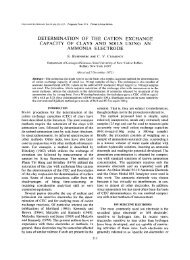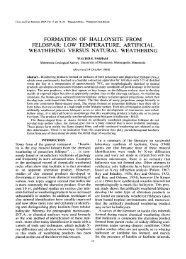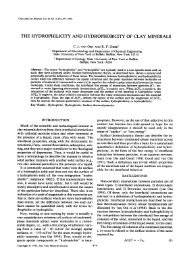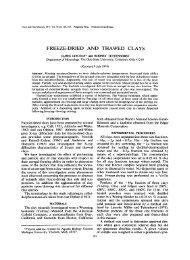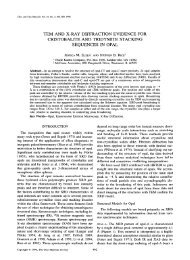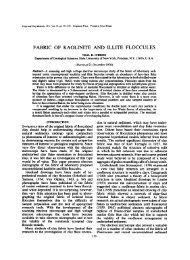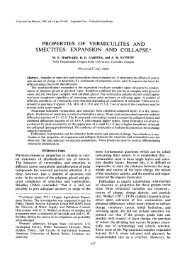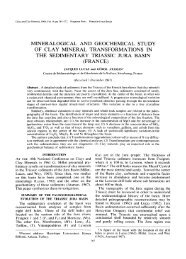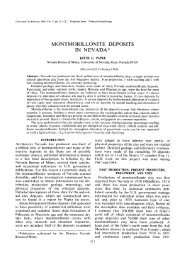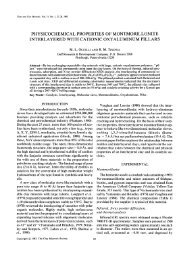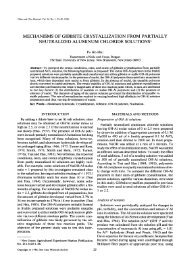halloysite deposits in the terraced hills washoe county, nevada
halloysite deposits in the terraced hills washoe county, nevada
halloysite deposits in the terraced hills washoe county, nevada
Create successful ePaper yourself
Turn your PDF publications into a flip-book with our unique Google optimized e-Paper software.
Clays and Clay M<strong>in</strong>erals, 1971, Vol. 19, pp. 71-74.<br />
Pergamon Press. Pr<strong>in</strong>ted <strong>in</strong> Great Brita<strong>in</strong><br />
HALLOYSITE DEPOSITS IN THE TERRACED HILLS<br />
WASHOE COUNTY, NEVADA*<br />
KEITIt G. PAPKE<br />
Nevada Bureau of M<strong>in</strong>es, University of Nevada, Reno, Nevada 89507<br />
(Received 1 May 1970)<br />
Abstract-- Large hydro<strong>the</strong>rmal <strong>deposits</strong> of <strong>halloysite</strong> clay occur <strong>in</strong> <strong>the</strong> Terraced Hills, Washoe County,<br />
Nevada and similar bodies probably are present elsewhere <strong>in</strong> <strong>the</strong> Bas<strong>in</strong> and Range prov<strong>in</strong>ce. The host<br />
rock, an andesitic tuff, is underla<strong>in</strong> and overla<strong>in</strong> by volcanic flows; all <strong>the</strong>se rocks are late Miocene to<br />
Pliocene <strong>in</strong> age. The clay bodies are composed mostly of <strong>halloysite</strong> with some iron oxides, variable<br />
amounts of feldspar and quartz, and locally some montmorillonite. Commonly all <strong>the</strong> pyroclastic unit<br />
is altered to <strong>halloysite</strong> material. In one locality, however, <strong>the</strong> <strong>halloysite</strong> body is restricted to <strong>the</strong> upper<br />
part and it is <strong>in</strong> sharp contact with underly<strong>in</strong>g, partly montmorillonitized tuff. The contact of a clay<br />
body with <strong>the</strong> overly<strong>in</strong>g basalt is dist<strong>in</strong>ct. Generally some <strong>halloysite</strong> is present <strong>in</strong> <strong>the</strong> lower part of <strong>the</strong><br />
basalt and montmorillonite occurs <strong>in</strong> both materials near <strong>the</strong>ir contact. The solutions that altered <strong>the</strong><br />
tuff were generated dur<strong>in</strong>g volcanism, rose along high-angle faults, and were restricted to <strong>the</strong> permeable<br />
and o<strong>the</strong>rwise favorable vitric tuff by <strong>the</strong> capp<strong>in</strong>g of relatively impermeable basalt.<br />
INTRODUCTION<br />
At.Tnotr6n <strong>halloysite</strong> formed by hydro<strong>the</strong>rmal<br />
processes is ra<strong>the</strong>r common, <strong>the</strong> occurrence of this<br />
clay m<strong>in</strong>eral <strong>in</strong> large relatively pure bodies has seldom<br />
been reported. This paper describes large<br />
<strong>deposits</strong> of <strong>halloysite</strong>, formed by <strong>the</strong> hydro<strong>the</strong>rmal<br />
alteration of volcanic rock, that occur <strong>in</strong> <strong>the</strong> Terraced<br />
Hills, Washoe County, Nevada (Fig. 1). One<br />
of <strong>the</strong> bodies is be<strong>in</strong>g exploited (Fig. 2) by <strong>the</strong><br />
Nevada Cement Co. as a source of clay for portland<br />
cement. Geologic conditions such as those<br />
responsible for <strong>the</strong> Terraced Hills <strong>deposits</strong> are<br />
common <strong>in</strong> <strong>the</strong> Bas<strong>in</strong> and Range prov<strong>in</strong>ce, and<br />
similar clay bodies probably are present elsewhere<br />
<strong>in</strong> <strong>the</strong> prov<strong>in</strong>ce.<br />
GEOLOGIC SETTING<br />
A series of andesitic to basaltic flows separated<br />
by a pyroclastic unit are exposed <strong>in</strong> <strong>the</strong> mapped<br />
area (Fig. 3); all <strong>the</strong>se rocks are late Miocene to<br />
Pliocene <strong>in</strong> age. The host rock of <strong>the</strong> clay is a pale<br />
red to moderate brown devitrified andesitic tuff that<br />
commonly conta<strong>in</strong>s fragments of pumice and o<strong>the</strong>r<br />
volcanic rocks. In some places arkose or conglomeratic<br />
arkose is present <strong>in</strong> <strong>the</strong> upper part of <strong>the</strong><br />
pyroclastic unit <strong>in</strong> beds 3-10 ft thick.<br />
The rocks underly<strong>in</strong>g <strong>the</strong> tuff are gray andesitic<br />
to basaltic flows with vesicular or, less commonly,<br />
porphyritic textures. The overly<strong>in</strong>g rocks are of<br />
*Publication authorized by <strong>the</strong> Director, Nevada<br />
Bureau of M<strong>in</strong>es.<br />
71<br />
basaltic composition. A dense, often vesicular, dark<br />
gray basalt <strong>in</strong> <strong>the</strong> lower 30-40 ft of this sequence<br />
has been differentiated on <strong>the</strong> geologic map (Fig.<br />
3) <strong>in</strong> some areas. This basalt is overla<strong>in</strong> by a relatively<br />
great thickness of flows that are more variable<br />
<strong>in</strong> color and texture. Typically <strong>the</strong>se are<br />
grayish red, f<strong>in</strong>e-gra<strong>in</strong>ed rocks; some have a coarse,<br />
vesicular texture.<br />
The extrusive rocks are broken <strong>in</strong>to a number of<br />
structural blocks by northwestward- and nor<strong>the</strong>astward-trend<strong>in</strong>g<br />
high-angle faults. The dip of <strong>the</strong><br />
rocks ranges from horizontal to 45 degrees.<br />
HALLOYSITE DEPOSITS<br />
The <strong>halloysite</strong> bodies were formed by hydro<strong>the</strong>rmal<br />
alteration of <strong>the</strong> tuff. Their present attitudes<br />
are due to displacement of <strong>the</strong> tuff by<br />
high-angle faults; probably most of <strong>the</strong> displacement<br />
occurred before <strong>the</strong> development of <strong>the</strong> clay.<br />
A few similar but more widely separated <strong>deposits</strong><br />
occur with<strong>in</strong> several miles east and sou<strong>the</strong>ast of <strong>the</strong><br />
mapped area.<br />
Commonly all <strong>the</strong> pyroclastic rock is altered to<br />
clay but <strong>in</strong> one area complete argillization is restricted<br />
to <strong>the</strong> upper part of <strong>the</strong> unit. Where arkose<br />
or conglomeratic arkose beds are present <strong>in</strong> <strong>the</strong><br />
pyroclastic unit, <strong>the</strong>y were partly replaced by <strong>halloysite</strong><br />
and montmoriilonite or by lesser amounts of<br />
montmorillonite only.<br />
The most extensive exposure of <strong>the</strong> tuff-arkoseclay<br />
unit is near <strong>the</strong> north border of Section 13, T.<br />
27 N, R. i 9 E, where <strong>the</strong> unit is nearly cont<strong>in</strong>uous<br />
for half a mile. Near <strong>the</strong> west end <strong>the</strong> rocks dip
72 K.G. PAPKE<br />
Terraced Hills Cloy Deposits<br />
;~Pyramid<br />
'~ Lake<br />
Reno<br />
eCorson City<br />
~<br />
Los Vegos<br />
Fig. 1. Index map of Nevada show<strong>in</strong>g location of Terraced<br />
Hills <strong>halloysite</strong> <strong>deposits</strong>.<br />
northward at low angles and <strong>the</strong> underly<strong>in</strong>g and<br />
overly<strong>in</strong>g volcanic flows are exposed with<strong>in</strong> a few<br />
feet of <strong>the</strong> contacts. The <strong>halloysite</strong> body has a<br />
stratigraphic thickness of about 60ft and it is<br />
overla<strong>in</strong> by about 10ft of arkose that conta<strong>in</strong>s<br />
some th<strong>in</strong> <strong>halloysite</strong> beds.<br />
In <strong>the</strong> eastern part of <strong>the</strong> nearly cont<strong>in</strong>uous exposure,<br />
however, <strong>the</strong> arkosic rocks are absent.<br />
Here <strong>the</strong> <strong>halloysite</strong> body becomes th<strong>in</strong>ner and is<br />
restricted to <strong>the</strong> upper part of <strong>the</strong> pyroclastic unit,<br />
immediately beneath <strong>the</strong> dense basalt. At <strong>the</strong> extreme<br />
eastern end, <strong>the</strong> <strong>halloysite</strong> has a thickness<br />
of about 10 ft. The contact of <strong>the</strong> <strong>halloysite</strong> and <strong>the</strong><br />
underly<strong>in</strong>g andesitic tuff is sharp, and <strong>the</strong>re is a<br />
pronounced color change. The tuff is completely<br />
devitrified and part of <strong>the</strong> matrix is altered to<br />
montmoriUonite.<br />
The contact of <strong>the</strong> underly<strong>in</strong>g volcanic rocks<br />
with <strong>the</strong> clay or tuff is not exposed <strong>in</strong> <strong>the</strong> mapped<br />
area but almost fresh volcanic rock is present <strong>in</strong><br />
several outcrops two or three feet stratigraphically<br />
below <strong>the</strong> clay. The contact between <strong>halloysite</strong> and<br />
<strong>the</strong> overly<strong>in</strong>g basalt, a disconformity with slight<br />
undulations, is well exposed <strong>in</strong> a few places (Fig. 4).<br />
The upper several feet of <strong>the</strong> clay is highly colored<br />
by iron oxides but <strong>the</strong> orig<strong>in</strong>al pyroclastic texture is<br />
still evident. The lower two feet of <strong>the</strong> basalt commonly<br />
is altered to a softer material that reta<strong>in</strong>s <strong>the</strong><br />
vesicular texture and, usually, <strong>the</strong> dark color. Irregular<br />
masses and ve<strong>in</strong>lets of clay material are<br />
present locally <strong>in</strong> <strong>the</strong> basalt near <strong>the</strong> contact. The<br />
alteration products <strong>in</strong> <strong>the</strong> basalt are montmorillonite<br />
and variable, but lesser, amounts of<strong>halloysite</strong>.<br />
Most of <strong>the</strong> <strong>halloysite</strong> clay is grayish orange to<br />
light brown. Much of <strong>the</strong> rema<strong>in</strong>der is very light<br />
gray; this color is more common <strong>in</strong> <strong>the</strong> upper half<br />
of a clay body. Usually <strong>the</strong> color variations are<br />
approximately parallel to <strong>the</strong> orig<strong>in</strong>al crude stratification<br />
of <strong>the</strong> rock. Hydrated iron oxides are <strong>the</strong><br />
pr<strong>in</strong>cipal color<strong>in</strong>g material <strong>in</strong> <strong>the</strong> clay. Hydrated<br />
iron oxides also are present <strong>in</strong> fractures and ve<strong>in</strong>lets;<br />
<strong>the</strong>se are especially abundant <strong>in</strong> <strong>the</strong> darkercolored<br />
clays.<br />
Coarse pyroclastic fragments were common <strong>in</strong><br />
<strong>the</strong> tuff and are still visible <strong>in</strong> <strong>the</strong> clay. Most are<br />
less than an <strong>in</strong>ch <strong>in</strong> diameter but <strong>the</strong> observed maximum<br />
is 18 <strong>in</strong>. Usually <strong>the</strong> fragments reta<strong>in</strong> <strong>the</strong>ir<br />
shape, texture, and color, even when <strong>the</strong>y have<br />
been almost completely converted to <strong>halloysite</strong><br />
(Fig. 5). Some of <strong>the</strong> larger or denser fragments<br />
have been only partly replaced.<br />
M<strong>in</strong>eralogy<br />
The clay bodies are composed of compact, brittle<br />
material with a dull to slightly waxy luster that<br />
slakes rapidly <strong>in</strong> water to form granules or small<br />
curved chips. Study of numerous samples by X-ray<br />
diffraction, differential <strong>the</strong>rmal analysis and <strong>the</strong><br />
optical microscope showed that <strong>the</strong> clay is composed<br />
pr<strong>in</strong>cipally of <strong>halloysite</strong>, hydrated iron<br />
oxides, and variable amounts of residual feldspar<br />
and residual or <strong>in</strong>troduced quartz. About 1 per<br />
cent magnetite is present <strong>in</strong> small dissem<strong>in</strong>ated<br />
gra<strong>in</strong>s. Montmorillonite was detected <strong>in</strong> a few<br />
samples.<br />
Most of <strong>the</strong> samples were cut from with<strong>in</strong> 1 ft of<br />
an exposed face. The samples were stored <strong>in</strong> airtight<br />
conta<strong>in</strong>ers, except while be<strong>in</strong>g pulverized <strong>in</strong> a<br />
mortar and pestle, to prevent any change of hydration<br />
state. X-ray diffraction studies showed that all<br />
samples were mixtures of <strong>the</strong> fully-hydrated and<br />
dehydrated forms of halioysite. Portions of some<br />
samples were dried <strong>in</strong> air for 48 hr and exam<strong>in</strong>ed<br />
aga<strong>in</strong> by X-ray. These conta<strong>in</strong>ed a much higher<br />
percentage of <strong>the</strong> dehydrated form than did <strong>the</strong><br />
orig<strong>in</strong>al material. It is probable that <strong>the</strong> fullyhydrated<br />
form is <strong>the</strong> only type present <strong>in</strong> deeper,<br />
unexposed portions of <strong>the</strong> <strong>deposits</strong>. Figure 6 shows<br />
typical X-ray diffraction and differential <strong>the</strong>rmal<br />
patterns of <strong>the</strong> hailoysite.<br />
In <strong>the</strong> area where <strong>the</strong> <strong>halloysite</strong> body is underla<strong>in</strong>
Fig. 2. View, look<strong>in</strong>g north, of a clay pit <strong>in</strong> <strong>the</strong> Terraced<br />
Hills.
Fig. 2. View, look<strong>in</strong>g north, of a clay pit <strong>in</strong> <strong>the</strong> Terraced<br />
Hills.
"" '~ "P'.%'L~"<br />
4500'<br />
4000'<br />
CROSS SECTION A-A'<br />
V,EW LOOK'NG NORTHWEST<br />
VERT,CAL EXAGGERAT,ON ZX<br />
EXPLANATION<br />
Surficial material<br />
E.<br />
I<br />
o<br />
I)!~ili'~::::~!::::::i::l<br />
Tb- basaltic rocks<br />
Tbl - basal unit,<br />
differentiated <strong>in</strong> places.<br />
Tp-pyroclastic rock<br />
Tc-pyroclastic rock, altered<br />
to clay <strong>in</strong> part.<br />
Undifferentiated volcanic<br />
rocks, may be Ta or Tb.<br />
Contact<br />
High-angle fault<br />
U=Upthrown side~D=Downthrown side<br />
strike<br />
and dip of planar structure<br />
Horizontal<br />
planar structure<br />
Inferred limits of clay material<br />
andesitic to basaltic rocks<br />
Trench<br />
or pit<br />
Fig. 3. Geologic map and cross section of <strong>the</strong> western part of <strong>the</strong> Tenaced Hills.
Fig. 4. Contact between <strong>halloysite</strong> body and overly<strong>in</strong>g<br />
basalt.<br />
Fig. 5. Halloysite clay, show<strong>in</strong>g pyroclastic fragments<br />
that have been almost completely converted to <strong>halloysite</strong>.
HALLOYSITE DEPOS1TS 73<br />
A<br />
SAMPLE AS RECEIVED<br />
/'/ I SAMPLE A,R DRIED ,<br />
X-RAY<br />
40<br />
COPPER RADIATION<br />
SCANNING SPEED; 10 2t9 PER MINUTE<br />
I I I I I I I I I I I I I I I I<br />
3O 20 I0<br />
a DEGREES 28<br />
I<br />
DTA<br />
~ SAMPLE RAN AS RECEIVED<br />
IOoC RISE PER MINUTE<br />
I I I I I I I I I I I<br />
I00 200 300 400 500 600 700 800 900 I000 I100<br />
TEMPERATURE *C<br />
Fig. 6. Typical X-ray diffraction and differential <strong>the</strong>rmal patterns of <strong>the</strong> <strong>halloysite</strong>.<br />
by tuff, <strong>halloysite</strong> was not detected <strong>in</strong> <strong>the</strong> six samples<br />
of tuff exam<strong>in</strong>ed. The m<strong>in</strong>eral montmorillonite<br />
is abundant <strong>in</strong> <strong>the</strong> tuff and <strong>in</strong> <strong>the</strong> lower several feet<br />
of <strong>the</strong> clay body. The presence of montmorillonite<br />
was confirmed by X-ray exam<strong>in</strong>ation of powder<br />
packs and oriented slides made from <strong>the</strong> --2/z fraction;<br />
<strong>the</strong>se were tested <strong>in</strong> air-dried state, after solvation<br />
with ethylene glycol, and by <strong>the</strong> Li § method of<br />
Greene-Kelly (1953). Gypsum occurs <strong>in</strong> both <strong>the</strong><br />
tuff and clay near <strong>the</strong> contact.<br />
At one place samples were taken at 6 <strong>in</strong>. <strong>in</strong>tervals<br />
on both sides of <strong>the</strong> <strong>halloysite</strong>-basalt contact<br />
and exam<strong>in</strong>ed by X-ray diffraction methods. Montmorillonite<br />
was first detected <strong>in</strong> <strong>the</strong> basalt 2 ft<br />
above <strong>the</strong> contact. The amount of montmorillonite<br />
<strong>in</strong>creased steadily from that po<strong>in</strong>t to a maximum <strong>in</strong><br />
<strong>the</strong> <strong>halloysite</strong> body one foot below <strong>the</strong> contact, and<br />
<strong>the</strong>n decreased to <strong>the</strong> limit of detection about 5 ft<br />
below <strong>the</strong> contact. In <strong>the</strong> samples of basalt, halioysite<br />
was ei<strong>the</strong>r present <strong>in</strong> m<strong>in</strong>or amounts or was not<br />
detected.<br />
Genesis<br />
Geologic mapp<strong>in</strong>g and laboratory studies furnished<br />
conv<strong>in</strong>c<strong>in</strong>g evidence that <strong>the</strong> <strong>halloysite</strong><br />
<strong>deposits</strong> were formed by hydro<strong>the</strong>rmal alteration<br />
of <strong>the</strong> pyroclastic rock beneath a relatively impermeable<br />
basalt flow. The most def<strong>in</strong>itive po<strong>in</strong>ts<br />
of evidence are; (1) <strong>the</strong> lack of gradational contact<br />
between <strong>the</strong> clay and underly<strong>in</strong>g rock such as<br />
might be expected <strong>in</strong> a residual deposit, (2) <strong>the</strong><br />
presence of some <strong>halloysite</strong> <strong>in</strong> <strong>the</strong> lower part of <strong>the</strong><br />
overly<strong>in</strong>g basalt, and (3) <strong>the</strong> crosscutt<strong>in</strong>g relationship<br />
of <strong>the</strong> clay body with its restriction locally to<br />
<strong>the</strong> upper part of <strong>the</strong> pyroclastic unit.<br />
The solutions that formed <strong>the</strong> <strong>halloysite</strong> are<br />
believed to have risen along high-angle faults and<br />
spread out <strong>in</strong>to <strong>the</strong> permeable and chemically<br />
favorable horizon. The tuffaceous rocks sandwiched<br />
between volcanic flows formed a natural<br />
channelway for solutions fed <strong>in</strong>to <strong>the</strong> area by crosscutt<strong>in</strong>g<br />
faults, and <strong>the</strong> solutions tended to be channeled<br />
<strong>in</strong>to <strong>the</strong> upper part of this permeable rock.<br />
Adjacent to major fault channelways, all of <strong>the</strong><br />
pyroclastic beds were replaced but far<strong>the</strong>r away<br />
only <strong>the</strong> upper beds were replaced. The alteration<br />
probably was accomplished by moderately acid<br />
solutions generated dur<strong>in</strong>g volcanism. The northwestward-trend<strong>in</strong>g<br />
faults <strong>in</strong> <strong>the</strong> Terraced Hills can<br />
be projected sou<strong>the</strong>astward to an active <strong>the</strong>rmal<br />
area on <strong>the</strong> north shore of Pyramid Lake 8 miles<br />
away.<br />
The hydro<strong>the</strong>rmal alteration was selective and<br />
<strong>the</strong> f<strong>in</strong>e-gra<strong>in</strong>ed, glassy material was more completely<br />
argillized than <strong>the</strong> fragments of crystall<strong>in</strong>e<br />
rock. Dur<strong>in</strong>g <strong>the</strong> hydrolytic process that converted<br />
<strong>the</strong> andesitic rock to clays, silicon, calcium, magnesium,<br />
sodium, potassium, and possibly some iron<br />
were removed and water was added. The overly<strong>in</strong>g<br />
rocks are not silicified such as <strong>the</strong>y are <strong>in</strong> some of
74 K.G. PAPKE<br />
<strong>the</strong> Mexican hydro<strong>the</strong>rmal clay <strong>deposits</strong> (Keller<br />
and Hanson, 1969). The m<strong>in</strong>eralogical zon<strong>in</strong>g, with<br />
<strong>halloysite</strong> predom<strong>in</strong>ant <strong>in</strong> <strong>the</strong> clay bodies and montmorillonite<br />
present near <strong>the</strong> edges and <strong>in</strong> <strong>the</strong> adjacent<br />
rocks, probably was completed dur<strong>in</strong>g a<br />
s<strong>in</strong>gle period of hydro<strong>the</strong>rmal activity.<br />
Glassy igneous rocks are especially susceptible<br />
to alteration, but <strong>in</strong> only a few cases has hydro<strong>the</strong>rmal<br />
alteration to <strong>halloysite</strong> been reported.<br />
Deposits formed by hydro<strong>the</strong>rmal alteration of<br />
glassy rocks have been described <strong>in</strong> <strong>the</strong> state of<br />
Jalisco, Mexico (Keller, 1963) and Iki Island, Japan<br />
(M<strong>in</strong>ato and Utada, 1969).<br />
Acknowledgments-The author thanks John Schill<strong>in</strong>g<br />
and Arthur Baker, Ill for critically read<strong>in</strong>g <strong>the</strong> manu-<br />
script and Tom Smith for help <strong>in</strong> preparation of illustrations.<br />
REFERENCES<br />
Greene-Kelly, R. (1953) The identification of montmorillonite<br />
<strong>in</strong> clays: J. Soil Sci. 4,233-237.<br />
Keller, W. D. (1963) Hydro<strong>the</strong>rmal kaol<strong>in</strong>ization (endellitization)<br />
of volcanic glassy rock: Clays and Clay<br />
M<strong>in</strong>erals 10, 333-343.<br />
Keller, W. D. and klanson, R. F. (1969) Classification<br />
and problems of hydro<strong>the</strong>rmal refractory clay <strong>deposits</strong><br />
<strong>in</strong> Mexico: Proc. Intern. Clay Conf. Voi. 1,305-312.<br />
M<strong>in</strong>ato, H. and Utada, M. (1969) Mode of occurrence and<br />
m<strong>in</strong>eralogy of <strong>halloysite</strong> from Iki, Japan: Proc. Intern.<br />
Clay Conf. Voi. 1,393-402.<br />
R~sumr-De grands drp6ts hydro<strong>the</strong>rmaux d'<strong>halloysite</strong> se rencontrent dans les Terraced Hills,<br />
Washoe County, Nevada, et il est probable qu'il en existe d'autres, ailleurs, darts la prov<strong>in</strong>ce de<br />
Bas<strong>in</strong> and Range. La roche mrre, un tuf andrsitique repose sur des coulres volcaniques, et en est<br />
aussi recouverte; toutes ces roches datent de l'rpoque miocrne suprrieur h plioc~ne. Les masses<br />
argileuses contiennent essentiellement de l'<strong>halloysite</strong>, avec en plus des oxydes de fer, des quantitrs<br />
variables de feldspath et de quartz, et localement de la montmorillonite. D'une fa~on grnrrale toute<br />
l'unit6 pyroclastique est altrrre en matdriel halloysitique. Dans une localit6 cependant, la masse<br />
d'<strong>halloysite</strong> est limitre 5_ la pattie suprrieure et se trouve, d'une fa~on nettement tranchre, au contact<br />
du tuf sous jacent, partiellement montmorillonitis~.. La limite entre la masse argileuse et le basalte qui<br />
la recouvre est nette. En grnrral, on trouve de l'<strong>halloysite</strong> duns la partie <strong>in</strong>frrieure du basalte, et de la<br />
montmorillonite dans les deux matrriaux, au vois<strong>in</strong>age de leur zone de contact. Les solutions qui oat<br />
altrr6 le tuf ont pris naissance pendant la p6riode de volcanisme et spat montres le long de failles/~<br />
pente 61evre; leur action a 6t6 limitre au tuf vitreux parce qu'il &ait perm6able, et que de toute<br />
manirre, il 6tait dispos6 favorablement ~ cause de son rev&ement par du basalte relativement<br />
impermrable.<br />
Kurzreferat-Grosse hydro<strong>the</strong>rmische Ablagerungen von Halloysit Ton kommen <strong>in</strong> den Terraced<br />
Hills, Washoe County, Nevada vor und ~ihnliche Vorkommnisse existieren vermutlich <strong>in</strong> der Bas<strong>in</strong><br />
und Range Prov<strong>in</strong>z. Das Wirtsgeste<strong>in</strong>, e<strong>in</strong> andesitischer Tuff, ist mit vulkanischen Fliessgeste<strong>in</strong>en<br />
unterlegt und iJberdeckt, wobei all diese Geste<strong>in</strong>e von sp~it-mioz~nischem bis plioz~<strong>in</strong>ischem Alter<br />
s<strong>in</strong>d. Die Tongeste<strong>in</strong>e bestehen haupts~ichlich aus Halloysit mit etwas Eisenoxyden, ver~nderlichen<br />
Mengen von Feldspat und Quarz, sowie 6rtlich etwas Montmorillonit. Im allgeme<strong>in</strong>en wird der<br />
gesamte pyroklastische Ste<strong>in</strong> <strong>in</strong> Halloysitmaterial ven<strong>in</strong>dert. An e<strong>in</strong>er Stelle bleibtjedoch das Halloysitgeste<strong>in</strong><br />
auf den Oberteil beschr/<strong>in</strong>kt und steht <strong>in</strong> scharfem Gegensatz zu dem darunter bef<strong>in</strong>dlichen<br />
montmorillonisierten Tuff. Die Beriihrungstelle e<strong>in</strong>es Tongeste<strong>in</strong>s mit dem dariiberliegenden Basalt<br />
ist deutlich. Im allgeme<strong>in</strong>en ist etwas Halloysit im unteren Teil des Basalts gegenwSa'tig und Montmorillonit<br />
kommt <strong>in</strong> beiden Materialen <strong>in</strong> der N/ihe der Beriihrungstelle vor. Die den Tuff ve~ndernden<br />
LOsungen s<strong>in</strong>d im Vulkanismus entstanden, stiogen an steilen Verwerfungen empor, und blieben<br />
zufolge der Bedeckung durch verh~iltnism~issig impermeablen Basalt auf den permeablen und auch<br />
sonst gi<strong>in</strong>stigen glasartigen Tuff beschd<strong>in</strong>kt.<br />
Pe3mMe -- Ha TeppacOBblX XO~MaX (Bumpy KaynTn, Henada) RMeIOTC.q 6onbmne rn~poxepMaJibHble<br />
MecTopo~tr~enna ran.qya3HToao~l rannbl; Bepowrno, anaJIorn,~nbie CKOIl.rleHl, nl ransIyaaaTa HMeIOTCll<br />
B neroTopux paltonax npOBUHUn~ Ba~CnH n Pal~Hd~. BMetttaIomaa nopoaa (aadeanTOBUt~ Tyqb)<br />
nodcranaeTca n noxpuBaeTca aaBom,~Mn noToraMa; no3pacT BCeX aTaX nopod OT nO3dHero Mnouena<br />
do naaoueHa. 3aue>xb raanu cocToI~r, raaBnb~M orpaaoM, n3 rasmyaanTa c ue,6osu, maM KOaatIeCTBOM<br />
OKHC.rlOB )Ke.rie3a; B pa3.rna'tlHblX KOJII,I~eCTBaX HarJ'IIOdaeTCR noJleBO~ I.nnaT it/r MeCTaMH<br />
B F.rlUHe OTMe~aeTc~I HeMHOFO MOHTMOpnJ'IJ'IOHHTa. O(51,1"11tO Beg:I, nnpogJIaC-l'HqecKI, Ifl MaTeplta..ri<br />
npenpallleH B raJ<strong>in</strong>ya3HTOiIOdO6HOe BeldeCTBO. Ha OdnOM y"IaCTKe, OdllaKo, ra.ri.rlya3HTOBOe Te.rio<br />
np~typo,~eno K Bepxne~ *IaCTH MeCTOpO~lC.deHIl~l; OHO ltMeeT ~IOTKHI~ KOHTaKT C HI, I)I(eJ'/e)KanlHM,<br />
'~acTn*VdO MOHTMOprI~nOHnTn3npOBaHHb~M TydpOM. KOHTaI(T F.rIHI-n'ICTOFO Tena c ~Ie~atttnM cBepxy<br />
6a3aJ'lbTOM Tar~e flB.rlneTc,.q "IeTKHM. O6blqHO neI(oTopoe ronn,tecTao Fasl.rlya3nTa 06Hapy~nBaeTca<br />
B nHx~nefi aacTn 6a3anbToBoro Te~a; y ~OHTaKTa B 6a3a-~hTe H ra.anya3nTono~ raaae na6~mdaeTca<br />
MOHTMOpHJI21OHHT. PaCTBOpbl, U3MeHI/BInHe Tydp, FeHepHOOBaJIHCb npH IIOOIIeccax ByJIKann3Ma~<br />
HOdHHMa2IHCb BdOJlb KpyTorlada}oulnx cKnadOK H tlHpKyJIHOOBa21H TOYIbKO B nponHuaeMOM CTeKYIO-<br />
BHdHOM Tytl~e HOd UOKpOBOM OTHOCHTe:IbHO HenpoHHuaeMoro 6a3a21bTa.



